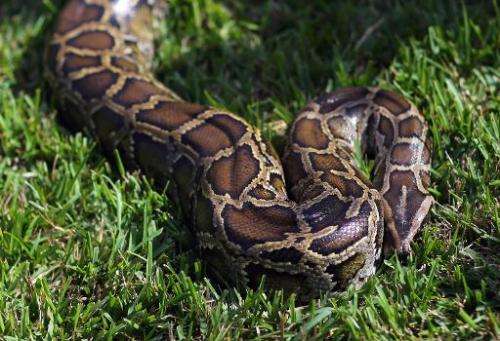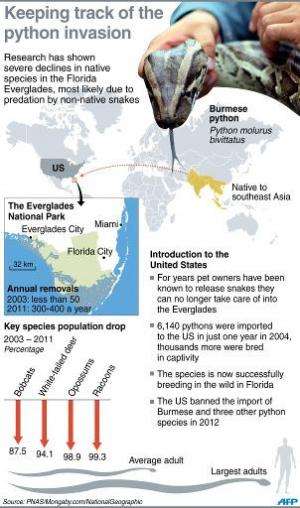Python's homing trick stuns scientists

The Burmese python has a built-in compass that allows it to slither home in a near-straight line even if released dozens of kilometres away, researchers said Wednesday.
Capable of growing over five metres (16 feet) long, pythons are among the world's largest snakes. Although native to South and Southeast Asia, the snakes have taken up residence in South Florida's Everglades National Park, possibly after being released as unwanted pets.
They have adapted so well to their new habitat that they now pose a serious threat to several species which they hunt as prey.
Scientists captured six of the pythons in the Everglades, placed them in sealed, plastic containers, and drove them to locations between 21 and 36 kilometres (13-22 miles) away.
They implanted radio trackers in the animals and followed their movements with GPS readings from a small fixed-wing plane—measuring their direction and speed.
All the snakes immediately oriented themselves towards the place where they were captured, with five of the six returning to within five kilometres (three miles) of that spot.
The sixth veered somewhat off course as it was nearing its destination.
The snakes travelled between 94 and 296 days, displaying "high motivation to reach home locations", according to the study, published in the Royal Society journal Biology Letters.

"This study provides evidence that Burmese pythons have navigational map and compass senses," the authors wrote.
No other snake species has yet been shown to possess a similar homing ability.
Such navigational skills suggest the python has a razor-sharp sense of territoriality. This could help combat the species in places where it is unwanted by predicting where the snake is likely to spread.
Burmese pythons eat everything from tiny birds to deer and even alligators. They swallow their food whole.
More information: Homing of invasive Burmese pythons in South Florida: evidence for map and compass senses in snakes,Biol. Lett. March 2014 vol. 10 no. 3 20140040 rsbl.royalsocietypublishing.or … ontent/10/3/20140040
Abstract
Navigational ability is a critical component of an animal's spatial ecology and may influence the invasive potential of species. Burmese pythons (Python molurus bivittatus) are apex predators invasive to South Florida. We tracked the movements of 12 adult Burmese pythons in Everglades National Park, six of which were translocated 21–36 km from their capture locations. Translocated snakes oriented movement homeward relative to the capture location, and five of six snakes returned to within 5 km of the original capture location. Translocated snakes moved straighter and faster than control snakes and displayed movement path structure indicative of oriented movement. This study provides evidence that Burmese pythons have navigational map and compass senses and has implications for predictions of spatial spread and impacts as well as our understanding of reptile cognitive abilities.
Journal information: Biology Letters
© 2014 AFP


















